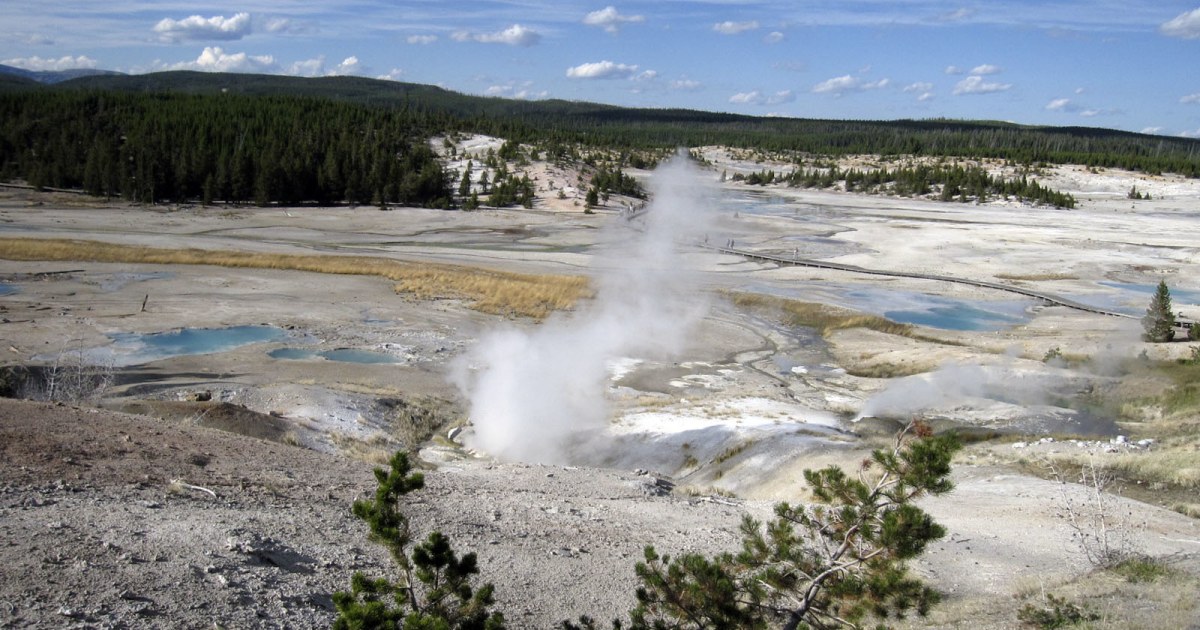Volcanic Activity Predictions: Studying Yellowstone's Magma Reservoir

Table of Contents
Monitoring Yellowstone's Magma Chamber: Techniques and Technologies
Predicting volcanic eruptions requires constant vigilance and the use of cutting-edge technologies. Scientists employ a multi-pronged approach, utilizing various techniques to monitor the slightest changes within Yellowstone's magma chamber.
Seismic Monitoring
Seismographs are the workhorses of volcanic monitoring, constantly listening for the subtle tremors and earthquakes that betray magma movement beneath the surface.
- Types of seismic waves: Scientists analyze both P-waves (primary) and S-waves (secondary) to determine the location and depth of seismic activity.
- Frequency of earthquakes: An increase in the frequency or intensity of earthquakes, especially swarms, can indicate a shift in magma pressure.
- Location of seismic events: Pinpointing the location of earthquakes helps scientists map the magma chamber's extent and identify areas of increased activity.
- Seismic tomography: This advanced technique uses seismic wave data to create three-dimensional images of the Earth's subsurface, providing a detailed view of the magma reservoir's structure.
Changes in seismic activity, even seemingly minor ones, can serve as an early warning sign of potential volcanic unrest.
Ground Deformation Measurement
The ground above a magma chamber can subtly rise or fall due to changes in magma pressure. Scientists use highly sensitive instruments to detect this deformation.
- GPS: Networks of GPS stations precisely track changes in ground elevation and horizontal movement.
- InSAR (Interferometric Synthetic Aperture Radar): Satellite-based InSAR measures ground deformation over large areas with remarkable precision.
- Tiltmeters: These instruments measure minute changes in the slope of the ground, providing additional data on magma movement.
By monitoring ground deformation, scientists can estimate changes in magma chamber pressure, a critical factor in eruption forecasting. Inflation (uplift) often indicates magma accumulation, while deflation (subsidence) may suggest magma release.
Geochemical Analysis
Monitoring the chemical composition of gases emitted from the ground and the water chemistry of hydrothermal features provides further clues about the state of the magma system.
- Types of gases monitored: Key gases include carbon dioxide (CO2) and sulfur dioxide (SO2), which can indicate changes in magma degassing.
- Location of monitoring stations: A network of monitoring stations across Yellowstone allows for comprehensive gas monitoring.
- Interpretation of gas ratios: Changes in the ratios of different gases can reflect changes in the magma's composition and pressure.
- Correlation with other data: Gas emission data is integrated with seismic and geodetic data to gain a holistic picture of volcanic activity.
Significant changes in gas composition and release rates can be strong indicators of increased volcanic activity.
Interpreting the Data: From Observation to Prediction
The vast amounts of data collected through monitoring require sophisticated analysis and interpretation.
Data Integration and Modeling
Scientists use advanced computer models to integrate diverse datasets (seismic, geodetic, geochemical) and create a comprehensive understanding of the magma reservoir's behavior.
- Types of models used: Numerical and statistical models simulate various processes within the magma chamber, predicting future behavior.
- Challenges in modeling complex systems: Modeling a complex system like a magma reservoir presents significant challenges, including uncertainties in initial conditions and model parameters.
- Limitations of predictive models: Current models can't precisely predict eruption timing, but they improve our understanding of the probability of eruptions.
Integrating data from multiple sources and applying complex models is crucial for improving our ability to understand and predict Yellowstone's volcanic activity.
Probabilistic Forecasting
It's crucial to understand that volcanic activity predictions aren't about pinpointing an exact eruption date. Instead, they involve probabilistic forecasting, assigning probabilities to eruptions within specific timeframes.
- Concept of eruption probabilities: Scientists assess the likelihood of an eruption within various timeframes (e.g., next decade, next century).
- Factors influencing uncertainty: The complexity of the magma system and limitations in our understanding introduce inherent uncertainty into predictions.
- Communication of risk to the public: Clearly communicating the probabilistic nature of volcanic predictions is vital to avoid panic and ensure responsible preparedness.
Understanding that predictions are probabilistic, not deterministic, is essential for effective risk management.
The Future of Volcanic Activity Predictions at Yellowstone
Ongoing research and technological advancements constantly refine our ability to predict volcanic activity.
Advancements in Technology
New technologies are revolutionizing volcanic monitoring, enhancing prediction accuracy.
- Improved sensors: More sensitive and robust sensors provide higher-quality data.
- AI/machine learning applications: AI can analyze massive datasets, identifying patterns and anomalies that might be missed by human analysts.
- Advanced satellite imagery: Sophisticated satellites provide increasingly detailed views of ground deformation and other subtle changes.
Future research will focus on integrating these new technologies to improve our predictive capabilities.
Public Awareness and Preparedness
Effective communication and public preparedness are vital for mitigating the risks associated with volcanic eruptions.
- Importance of emergency plans: Communities near Yellowstone need comprehensive emergency plans to ensure safe evacuations.
- Communication strategies during crises: Clear, timely communication from scientists and authorities is vital during volcanic crises.
- Community involvement: Involving local communities in preparedness efforts enhances their resilience to volcanic hazards.
Public education and preparedness are crucial for reducing the impact of potential future eruptions.
Conclusion: Improving Volcanic Activity Predictions for a Safer Future
Predicting volcanic activity at Yellowstone involves a multifaceted approach, integrating seismic monitoring, ground deformation measurements, geochemical analysis, and sophisticated computer modeling. While challenges and uncertainties remain, ongoing research and technological advancements steadily improve our ability to assess eruption probabilities. Continuous monitoring and research are crucial for refining volcanic activity predictions and enhancing preparedness strategies. Stay informed about the latest research on volcanic activity predictions and the ongoing monitoring of Yellowstone's magma reservoir to better understand and prepare for potential future events.

Featured Posts
-
 Il Giorno 10 Marzo Almanacco Santo Del Giorno E Proverbio
May 27, 2025
Il Giorno 10 Marzo Almanacco Santo Del Giorno E Proverbio
May 27, 2025 -
 Chelsea Eyeing Panichelli Could A Move Materialize
May 27, 2025
Chelsea Eyeing Panichelli Could A Move Materialize
May 27, 2025 -
 Victor Osimhen Transfer Update Man Utds Improved Position After Chelseas Stance
May 27, 2025
Victor Osimhen Transfer Update Man Utds Improved Position After Chelseas Stance
May 27, 2025 -
 Kennedy And King Assassination Files Public Release Nearing
May 27, 2025
Kennedy And King Assassination Files Public Release Nearing
May 27, 2025 -
 Fruehjahrskonzert In Viehdorf Programm And Kartenverkauf
May 27, 2025
Fruehjahrskonzert In Viehdorf Programm And Kartenverkauf
May 27, 2025
